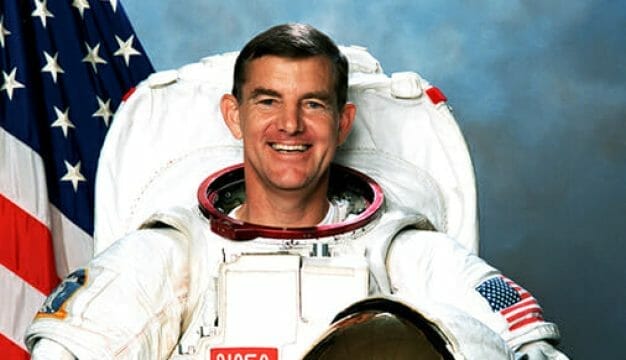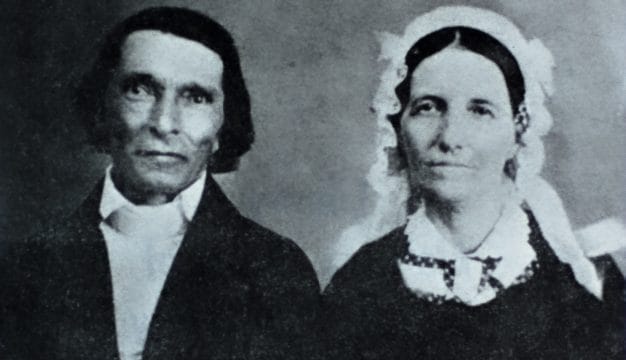Kathryn Thornton
Nuclear physicist Kathryn Ryan Cordell Thornton (1952- ) was an astronaut for the National Aeronautics and Space Administration (NASA) from 1985-1996; she flew four missions for the agency’s Space Shuttle orbiter program. During her more than 970 hours in space, she helped upgrade the Hubble Space Telescope, tested systems for the construction of the International Space Station (ISS), and helped launch and repair satellites. She went on to a distinguished career as an academic and scientific researcher. She is one of six astronauts who have graduated from Auburn University.
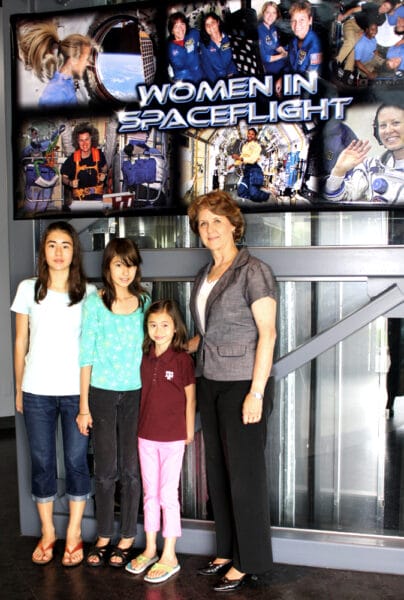 Kathryn Thornton at the Space Foundation
Thornton was born in Montgomery, Montgomery County, on August 17, 1952, to William and Elsie Cordell, restaurant owners; she was one of six children. As a child she participated in the Girl Scouts and played softball. Thornton graduated from Sidney Lanier High School in Montgomery in 1970 and entered Auburn University in Auburn, Lee County, to study physics. After completing a bachelor of science in 1974, she enrolled at the University of Virginia (UVA) in Charlottesville, focusing her research on nuclear physics. She completed a master’s degree in 1977, a PhD in 1979, and performed a year of postdoctoral work for the North Atlantic Treaty Organization at the Max Planck Institute for Nuclear Physics in Heidelberg, West Germany. Thornton then took a job with the U.S. Army Foreign Science and Technology Center in Charlottesville. Thornton married physicist Stephen Thornton, whom she had met at UVA, and the couple would have three children.
Kathryn Thornton at the Space Foundation
Thornton was born in Montgomery, Montgomery County, on August 17, 1952, to William and Elsie Cordell, restaurant owners; she was one of six children. As a child she participated in the Girl Scouts and played softball. Thornton graduated from Sidney Lanier High School in Montgomery in 1970 and entered Auburn University in Auburn, Lee County, to study physics. After completing a bachelor of science in 1974, she enrolled at the University of Virginia (UVA) in Charlottesville, focusing her research on nuclear physics. She completed a master’s degree in 1977, a PhD in 1979, and performed a year of postdoctoral work for the North Atlantic Treaty Organization at the Max Planck Institute for Nuclear Physics in Heidelberg, West Germany. Thornton then took a job with the U.S. Army Foreign Science and Technology Center in Charlottesville. Thornton married physicist Stephen Thornton, whom she had met at UVA, and the couple would have three children.
Thornton entered NASA’s preliminary astronaut training program in 1984, and in May of that year, she was selected as one of 17 new astronauts out of 5,000 applicants. She then moved to Houston, Texas, for training and graduated in July 1985.
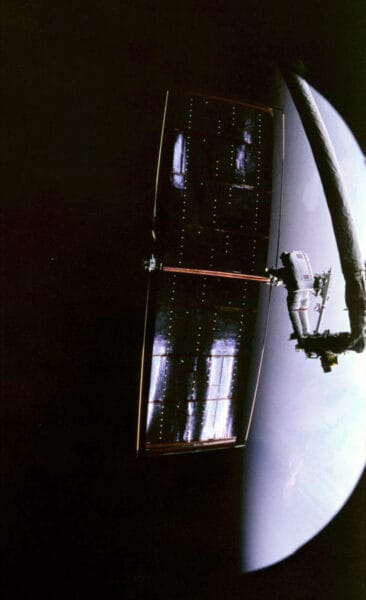 Kathryn Thornton in Space
She was assigned the rank of “mission specialist,” which is a crew member charged with carrying out functions other than piloting the craft and specific to each mission. Thornton’s first flight into space lasted five days onboard the Space Shuttle Discovery (OV-103), which launched on November 22, 1989. The flight crew deployed a U.S. Department of Defense satellite that was designed to listen in on military communications in the Soviet Union. As a mission specialist, Thornton helped control the equipment that deployed the satellite.
Kathryn Thornton in Space
She was assigned the rank of “mission specialist,” which is a crew member charged with carrying out functions other than piloting the craft and specific to each mission. Thornton’s first flight into space lasted five days onboard the Space Shuttle Discovery (OV-103), which launched on November 22, 1989. The flight crew deployed a U.S. Department of Defense satellite that was designed to listen in on military communications in the Soviet Union. As a mission specialist, Thornton helped control the equipment that deployed the satellite.
Thornton’s second flight marked the first voyage of the shuttle Endeavour (OV-105), the orbiter built to replace the Challenger, destroyed in 1986. Launched on May 7, 1992, Endeavour‘s crew retrieved and repaired a stranded Intelsat communications satellite and ran a series of construction experiments on a truss that would serve as a major component in constructing NASA’s forthcoming ISS. The latter activity afforded Thornton her first opportunity for an extravehicular activity (EVA), or “spacewalk.”
Thornton’s third mission, launched on December 2, 1993, was again aboard the Endeavour. During the 11-day flight, she helped repair the troubled Hubble Space Telescope, which had been sent into orbit with a flawed mirror. During her initial EVA, she was part of a two-person crew that installed two new solar panels on the Hubble. Her second EVA involved replacing an important optical correction instrument to account for the flawed optics and to give the telescope a much-needed boost in power.
 Space Shuttle Columbia Crew, 1995
The mission gave her a total of 21 EVA hours, a record for women astronauts that she held until 2006, when it was broken by Sunita Williams.
Space Shuttle Columbia Crew, 1995
The mission gave her a total of 21 EVA hours, a record for women astronauts that she held until 2006, when it was broken by Sunita Williams.
Her final shuttle flight, launched October 20, 1995, was aboard Columbia (OV-102). This flight was the second mission to incorporate the portable and reusable Spacelab, also known as the United States Microgravity Laboratory. This 16-day mission, during which Thornton served as payload commander, focused on basic research in biotechnology, materials science, and fluid physics, much like the work that was being tasked for the future ISS.
Thornton retired from NASA on August 1, 1996, to take a faculty position at UVA’s School of Engineering and Applied Sciences and serve as the director for the Center for Science Education. Throughout her career, Thornton has strongly advocated for a continued human presence in space. In 2000, she served on a team to evaluate potential plans for Mars exploration.
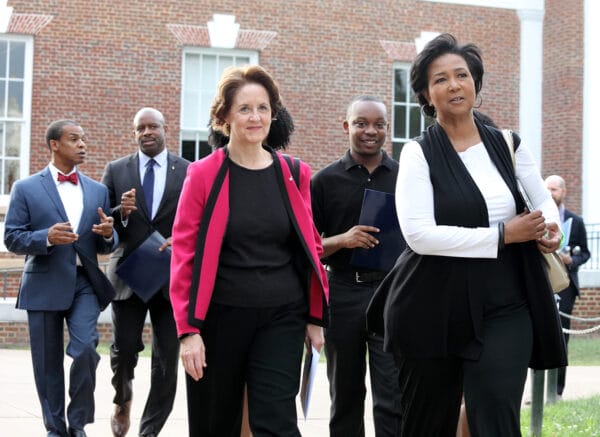 Kathryn Thornton and Mae Jemison
In 2003, she served on NASA’s Return to Flight Task Group, which was charged with recommending policy changes to the shuttle program in the wake of the Columbia disaster. She participated in a workshop to discuss the importance of exploration and science in February 2008, followed by a presentation before a congressional committee the following April urging support for human exploration beyond low-Earth orbit. She has served on the National Research Council’s Aeronautics and Space Engineering Board and currently serves as a board member for the Space Foundation and the Astronaut Scholarship Foundation.
Kathryn Thornton and Mae Jemison
In 2003, she served on NASA’s Return to Flight Task Group, which was charged with recommending policy changes to the shuttle program in the wake of the Columbia disaster. She participated in a workshop to discuss the importance of exploration and science in February 2008, followed by a presentation before a congressional committee the following April urging support for human exploration beyond low-Earth orbit. She has served on the National Research Council’s Aeronautics and Space Engineering Board and currently serves as a board member for the Space Foundation and the Astronaut Scholarship Foundation.
In 1992, the American Legion Auxiliary presented Thornton with the Woman of the Year award for her accomplishments as “one of America’s preeminent scientists.” She received NASA’s Distinguished Service Medal in 1996, in addition to several other NASA medals as well as the National Intelligence Medal of Achievement. Thornton was inducted into the Astronaut Hall of Fame in 2010.
Additional Resources
Richards, Zak. “Engineering School’s Kathryn Thornton Will Be Inducted into the Astronaut Hall of Fame.” UVA Today, May 27, 2010; http://news.virginia.edu/content/engineering-schools-kathryn-thornton-will-be-inducted-astronaut-hall-fame#sthash.95dLwX47.dpuf
